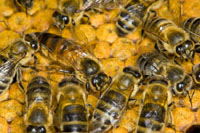Bee Friendly! – Part 4: Examining the Hive

In the final part of Bee Friendly, Paul Hirons checks his bees before closing up the hive ...
The Queen Excluder and Brood Box
I look down and see the Queen Excluder. This stops the Queen laying eggs in the honey super above the brood box. I look down onto the Queen Excluder and see the colony of bees. I reach for my smoker and gently smoke them and hear the humming noise go loud again. They are gently murmuring. I use my hive tool to gently prise up the Queen Excluder and I peel it off gently. I don’t want to create any fuss.
Below me are eleven frames and I want to inspect each frame. I need to create a space so I look at frames 1 and 11 to see which one I could remove. I am in luck; frame 1 has nothing but drawn foundation.
Before I remove it I smoke the bees gently. I remove frame 1 and look at each side for any damage, wax moth, European Foul Brood, Chalk Brood and any one of a dozen things that might be in my hive. I gently slide frame 2 across so I can remove it. It is covered in bees. I hold it closer to my face and look at the pollen stores and capped honey on the frame.
The brood is shaped like a Cadbury's creme egg. Stores are the chocolate round the outside, usually honey on the very outside, then there's pollen, then there are worker or larvae sealed brood cells, and in the middle there are eggs. However this is not always the case as sealed brood will hatch and eggs can be seen all the way to the stores.
Examining each frame I keep a look out for the Queen. The Queen is bigger than the worker bees and has a more pointed body than the drones. OK, so she is not very easy to spot, but will be found on a frame with new eggs on. I find the Queen always runs to the underside of the frame. I’m careful to hold the brood frames over the brood box in case she falls off.
If I can, I put a spot of paint on the Queen’s thorax with a special pen. I have a Queen catcher that clips over her and I can gently paint her in the colour for the year. I think this year is green.
There are pests and diseases I’m looking for in my brood inspection, and I’m going to do a simple article on the things you need to look out for.
After careful examination of the Brood Box, I replace all the frames back in the order they were. I smoke the bees so they go down in the brood box and gently slide the Queen Excluder back in place.
Putting the Hive Back Together
I use my bee brush to gently sweep away any Bees that are crawling on the hive sides where the boxes rest on each other. A sure way to get bees angry is to crush bees when moving hive parts about. I’m very careful to replace everything as I found it.
The Varroa Floor
On all my hives I have a mesh floor that is simply referred to as the Varroa Floor. Varroa is a parasite that lives on bees. The female Varroa mite prefers drone larvae and goes into drone cells when the Queen has laid an egg. The female Varrroa mite remains with the larvae while the cell is capped. The drone emerges sometimes stunted and weak. The female Varroa mite will have produced offspring in the drone cell, usually one male and one female mite, thus increasing the infestation of the hive.
There are ways of dealing with Varroa. The use of medicines and chemicals is only possible when the honey supers are not on the hive.
The biological method is to replace the outer brood frames with short frames that encourage the bees to create drone cells on the bottom, free half of the short foundation frame. I don’t know why they do this, but they just do. These short frames can be removed every 16 days or so (remember the Drones take 24 days to hatch) and put in the freezer, killing the host drone larvae and also the varroa.
Another method to control Varroa is to dust the bees with icing sugar. Just pinch the icing sugar pot from the kitchen, fill it with icing sugar and dust the bees in a cloud of icing sugar. This forces them to groom themselves and a lot of Varroa mites are groomed off and fall through the mesh onto the ground. The Varroa floor mesh allows mites to drop through. It has a slide in drawer that can be loaded with greaseproof paper and a few sprays of One Cal will make the mites stick to the paper and allow you to count any dropped off varroa mites each week. Infestations are classed by the amount of mites collected in a week.
Good Luck With Your Beekeeping!!
Comments are closed for this post.

Hi, it has been somewhile since I have checked in on this website. I most certainly found this exceptionally interesting to say the least! I have yet to purchase some land via here but I would find it even more interesting and purposeful to acquire some wood and land that has a thriving Bee population to look after. Please keep up the very useful guides. I shall keep an eager eye out (and also catch up on your previous three parts in the meantime) for your next tuitional guides.
Thankyou very much again
A newly avid reader
EuroB0b
4 May, 2010